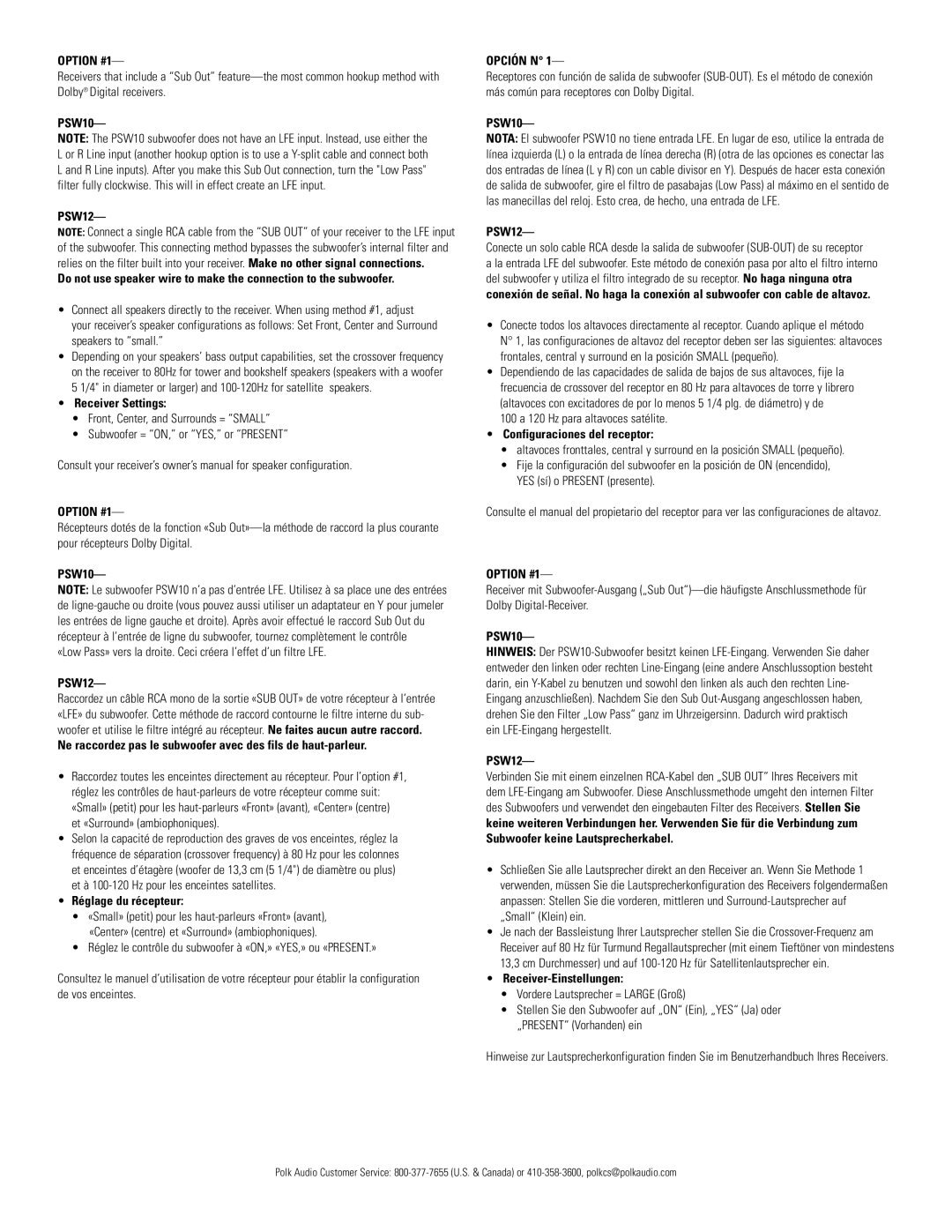OPTION #1—
Receivers that include a “Sub Out” feature—the most common hookup method with Dolby® Digital receivers.
PSW10—
NOTE: The PSW10 subwoofer does not have an LFE input. Instead, use either the L or R Line input (another hookup option is to use a Y-split cable and connect both L and R Line inputs). After you make this Sub Out connection, turn the "Low Pass" filter fully clockwise. This will in effect create an LFE input.
PSW12—
NOTE: Connect a single RCA cable from the “SUB OUT” of your receiver to the LFE input of the subwoofer. This connecting method bypasses the subwoofer’s internal filter and relies on the filter built into your receiver. Make no other signal connections.
Do not use speaker wire to make the connection to the subwoofer.
•Connect all speakers directly to the receiver. When using method #1, adjust your receiver’s speaker configurations as follows: Set Front, Center and Surround speakers to “small.”
•Depending on your speakers’ bass output capabilities, set the crossover frequency on the receiver to 80Hz for tower and bookshelf speakers (speakers with a woofer 5 1/4" in diameter or larger) and 100-120Hz for satellite speakers.
•Receiver Settings:
•Front, Center, and Surrounds = “SMALL”
•Subwoofer = “ON,” or “YES,” or “PRESENT”
Consult your receiver’s owner’s manual for speaker configuration.
OPTION #1—
Récepteurs dotés de la fonction «Sub Out»—la méthode de raccord la plus courante pour récepteurs Dolby Digital.
PSW10—
NOTE: Le subwoofer PSW10 n’a pas d’entrée LFE. Utilisez à sa place une des entrées de ligne-gauche ou droite (vous pouvez aussi utiliser un adaptateur en Y pour jumeler les entrées de ligne gauche et droite). Après avoir effectué le raccord Sub Out du récepteur à l’entrée de ligne du subwoofer, tournez complètement le contrôle
«Low Pass» vers la droite. Ceci créera l’effet d’un filtre LFE.
PSW12—
Raccordez un câble RCA mono de la sortie «SUB OUT» de votre récepteur à l’entrée «LFE» du subwoofer. Cette méthode de raccord contourne le filtre interne du sub- woofer et utilise le filtre intégré au récepteur. Ne faites aucun autre raccord.
Ne raccordez pas le subwoofer avec des fils de haut-parleur.
•Raccordez toutes les enceintes directement au récepteur. Pour l’option #1, réglez les contrôles de haut-parleurs de votre récepteur comme suit: «Small» (petit) pour les haut-parleurs «Front» (avant), «Center» (centre) et «Surround» (ambiophoniques).
•Selon la capacité de reproduction des graves de vos enceintes, réglez la fréquence de séparation (crossover frequency) à 80 Hz pour les colonnes et enceintes d’étagère (woofer de 13,3 cm (5 1/4") de diamètre ou plus) et à 100-120 Hz pour les enceintes satellites.
•Réglage du récepteur:
•«Small» (petit) pour les haut-parleurs «Front» (avant), «Center» (centre) et «Surround» (ambiophoniques).
•Réglez le contrôle du subwoofer à «ON,» «YES,» ou «PRESENT.»
Consultez le manuel d’utilisation de votre récepteur pour établir la configuration de vos enceintes.
OPCIÓN N° 1—
Receptores con función de salida de subwoofer (SUB-OUT). Es el método de conexión más común para receptores con Dolby Digital.
PSW10—
NOTA: El subwoofer PSW10 no tiene entrada LFE. En lugar de eso, utilice la entrada de línea izquierda (L) o la entrada de línea derecha (R) (otra de las opciones es conectar las dos entradas de línea (L y R) con un cable divisor en Y). Después de hacer esta conexión de salida de subwoofer, gire el filtro de pasabajas (Low Pass) al máximo en el sentido de las manecillas del reloj. Esto crea, de hecho, una entrada de LFE.
PSW12—
Conecte un solo cable RCA desde la salida de subwoofer (SUB-OUT) de su receptor
a la entrada LFE del subwoofer. Este método de conexión pasa por alto el filtro interno del subwoofer y utiliza el filtro integrado de su receptor. No haga ninguna otra
conexión de señal. No haga la conexión al subwoofer con cable de altavoz.
•Conecte todos los altavoces directamente al receptor. Cuando aplique el método
N° 1, las configuraciones de altavoz del receptor deben ser las siguientes: altavoces frontales, central y surround en la posición SMALL (pequeño).
•Dependiendo de las capacidades de salida de bajos de sus altavoces, fije la frecuencia de crossover del receptor en 80 Hz para altavoces de torre y librero (altavoces con excitadores de por lo menos 5 1/4 plg. de diámetro) y de
100 a 120 Hz para altavoces satélite.
•Configuraciones del receptor:
•altavoces fronttales, central y surround en la posición SMALL (pequeño).
•Fije la configuración del subwoofer en la posición de ON (encendido), YES (sí) o PRESENT (presente).
Consulte el manual del propietario del receptor para ver las configuraciones de altavoz.
OPTION #1—
Receiver mit Subwoofer-Ausgang („Sub Out“)—die häufigste Anschlussmethode für Dolby Digital-Receiver.
PSW10—
HINWEIS: Der PSW10-Subwoofer besitzt keinen LFE-Eingang. Verwenden Sie daher entweder den linken oder rechten Line-Eingang (eine andere Anschlussoption besteht darin, ein Y-Kabel zu benutzen und sowohl den linken als auch den rechten Line- Eingang anzuschließen). Nachdem Sie den Sub Out-Ausgang angeschlossen haben, drehen Sie den Filter „Low Pass“ ganz im Uhrzeigersinn. Dadurch wird praktisch
ein LFE-Eingang hergestellt.
PSW12—
Verbinden Sie mit einem einzelnen RCA-Kabel den „SUB OUT“ Ihres Receivers mit dem LFE-Eingang am Subwoofer. Diese Anschlussmethode umgeht den internen Filter des Subwoofers und verwendet den eingebauten Filter des Receivers. Stellen Sie
keine weiteren Verbindungen her. Verwenden Sie für die Verbindung zum Subwoofer keine Lautsprecherkabel.
•Schließen Sie alle Lautsprecher direkt an den Receiver an. Wenn Sie Methode 1 verwenden, müssen Sie die Lautsprecherkonfiguration des Receivers folgendermaßen anpassen: Stellen Sie die vorderen, mittleren und Surround-Lautsprecher auf „Small“ (Klein) ein.
•Je nach der Bassleistung Ihrer Lautsprecher stellen Sie die Crossover-Frequenz am Receiver auf 80 Hz für Turmund Regallautsprecher (mit einem Tieftöner von mindestens 13,3 cm Durchmesser) und auf 100-120 Hz für Satellitenlautsprecher ein.
•Receiver-Einstellungen:
•Vordere Lautsprecher = LARGE (Groß)
•Stellen Sie den Subwoofer auf „ON“ (Ein), „YES“ (Ja) oder „PRESENT“ (Vorhanden) ein
Hinweise zur Lautsprecherkonfiguration finden Sie im Benutzerhandbuch Ihres Receivers.
